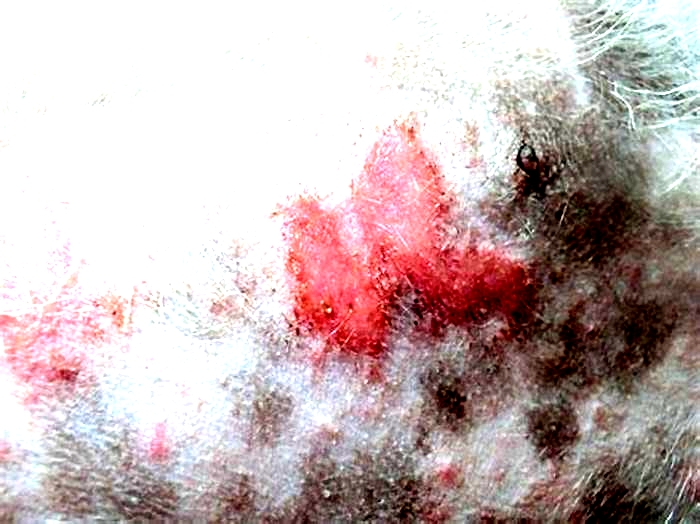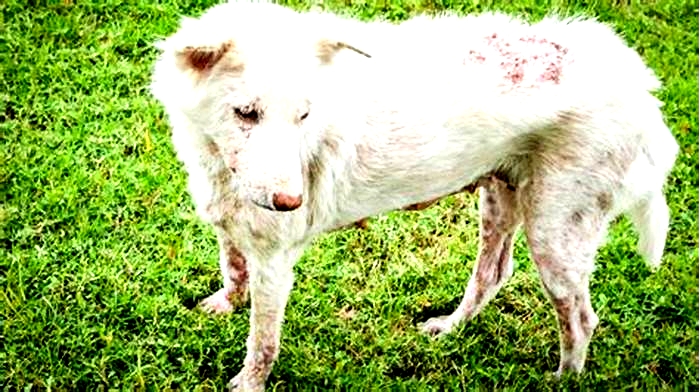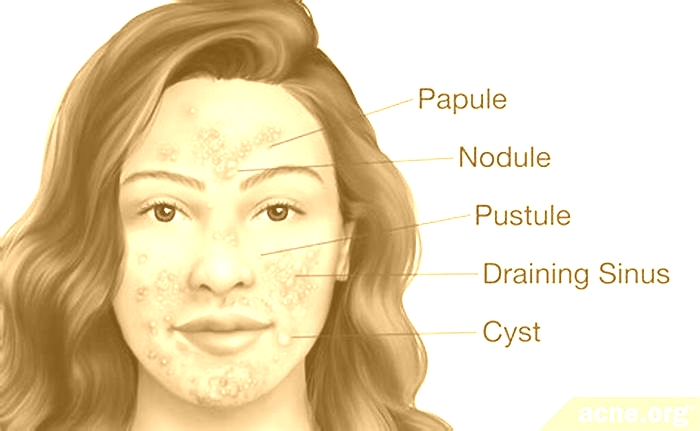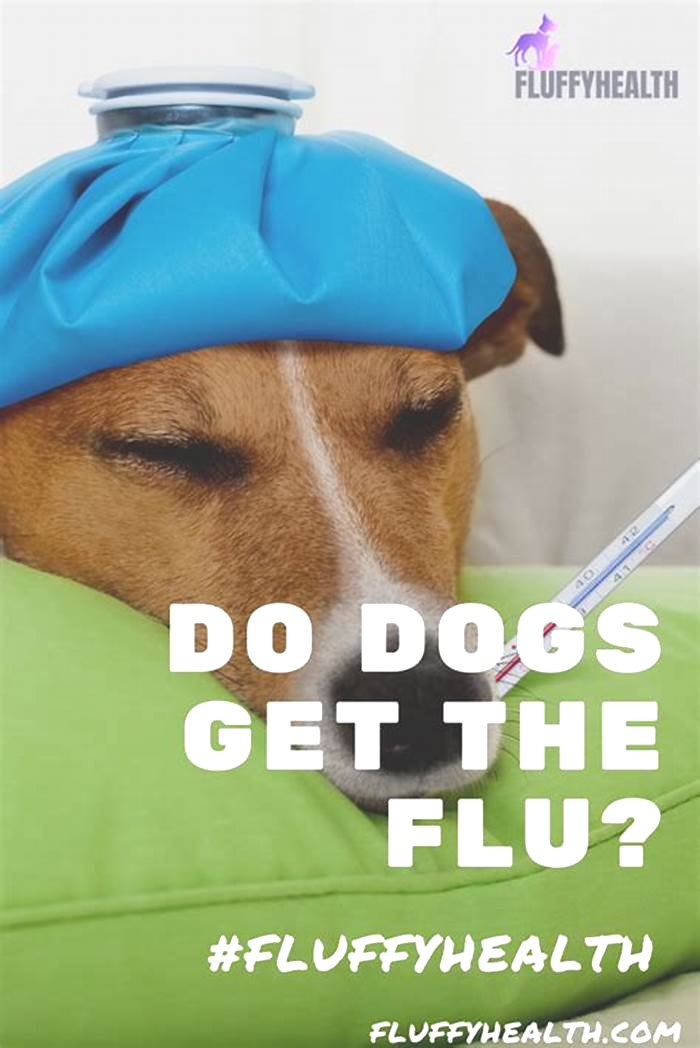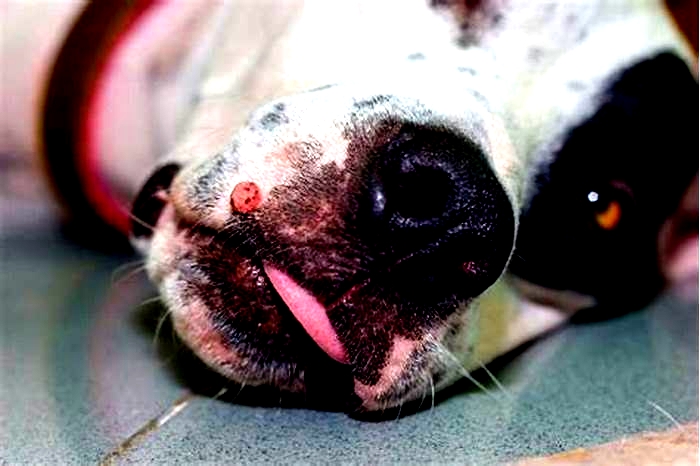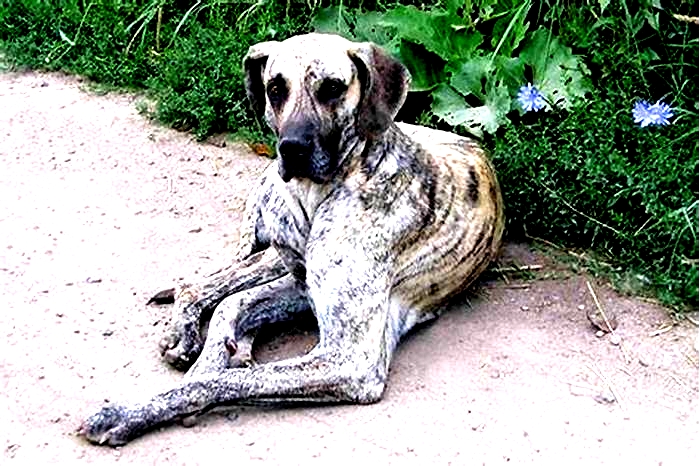Is pyoderma in dogs serious
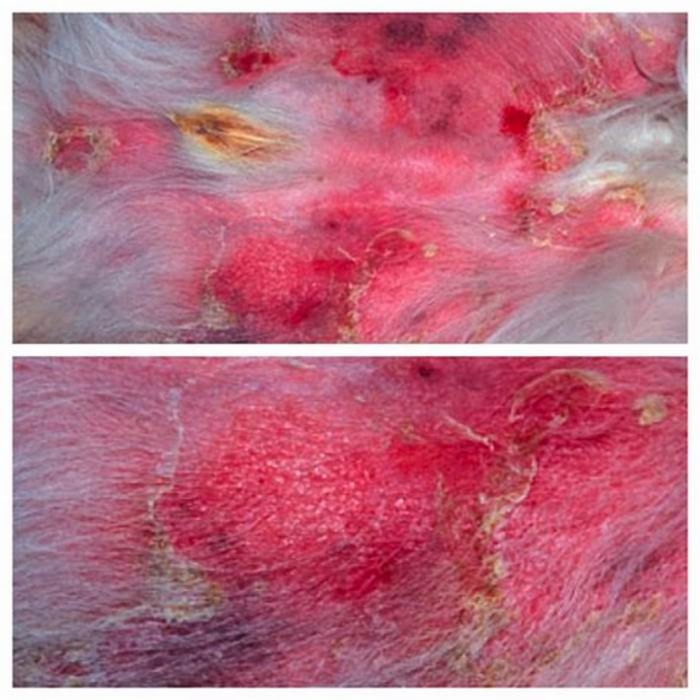
Pyoderma in Dogs
Pyoderma literally means pus in the skin. It can be caused by infection, inflammation, or cancer and is common in dogs.
Most cases of pyoderma are caused by bacterial infections. Most of these are superficial and secondary to a variety ofother conditions, such as allergies or parasites. Pyoderma that occurs in otherwise healthy animals usually resolves completely with appropriate antibiotics. Warm, moist areas on the skin, such as lip folds, facial folds, armpits, feet, and neck folds, often have higher bacterial counts than other areas and are at an increased risk for infection. Pressure points, such as elbows, are prone to infections due to repeated pressure. Any skin disease that changes the normally dry, desert-like environment to a more humid environment can cause overcolonization of the skin with bacteria.
The most common sign of bacterial pyoderma is excessive scaling. Scales are often pierced by hairs. Itching is variable. In dogs, superficial pyoderma commonly appears as bald patches, welts around hairs, and scabbing. Shorthaired breeds often have multiple welts that look similar to hives because the inflammation in and around the follicles causes the hairs to stand more erect. These hairs are often easily removed, which distinguishes pyoderma from hives. Hair loss leads to small bald patches in affected areas. At the margins of the hair loss, there may be redness and welts but these signs are often absent in shorthaired breeds. The signs of deep pyoderma in dogs include pain, crusting, odor, and secretions of blood and pus. Redness, swelling, ulceration, scabs, and blisters may also be seen. The bridge of the muzzle, chin, elbows, hocks, knees, and spaces between the toes are more prone to deep infections, but any area may be involved.
Diagnosis is based on signs. Diagnosis of pyoderma must also include steps to identify any underlying causes. These include fleas, allergies, hypothyroidism, Cushing disease, and poor grooming. Multiple deep skin scrapings are needed to exclude parasitic infections. Bacterial and fungal cultures may also betaken.
The most common causes of recurrent bacterial pyoderma include failure to treat underlying causes, use of glucocorticoid drugs, and inappropriate treatment with prescribed antibiotic medications. You may contribute to a recurrence of pyoderma in your dog if you dont carefully follow your veterinarians treatment directions. Even though your dog may seem better after only a few days or a week, it is still very important for you to continue the prescribed treatment program for the full length of time. The bacteria causing pyoderma can still be present and ready to multiply again if the complete course of medication is not given.
Antibiotic treatment should last for at least 3 weeks and preferably for 4 weeks. All signs (except for hair regrowth and resolution of increased pigmentation) should be gone for at least 7 days before antibiotics are discontinued. Longterm, recurrent, or deep pyodermas typically require 8 to 12 weeks or longer to heal completely. Topical antibiotics may also be used in some cases.
Attention to grooming is crucial. The hair coat should be clipped in dogs with deep pyoderma and a professional grooming is recommended in medium to longhaired dogs with superficial pyoderma. This will remove excessive hair that can trap debris and bacteria and will help grooming.
Dogs with superficial pyoderma should be bathed with a shampoo recommended by its veterinarian. Baths should be given 2 to 3 times per week during the first 2 weeks of treatment and then 1 to 2times per week until the infection clears. Dogs with deep pyoderma may require daily baths with medicated shampoos diluted to one-half or one-quarter strength. Shampooing will remove bacteria, crusts, and scales, and reduce itching, odor, and oiliness. Improvement may not be evident for at least 14 to 21 days, and recovery may not be as rapid as expected. Your veterinarian can recommend the appropriate bathing program for your pets condition. Medicated shampoos usually need to remain on the coat for 10 minutes in order to be effective.
Also see professional content regarding pyoderma.
Pyoderma in Dogs
What Is Pyoderma in Dogs?
Pyoderma is the medical term for a bacterial skin infection and it is one of the most common diseases in dogs. Dogs are at increased risk for pyoderma due to many features of their skin. For example, a dogs skin has a thinner outer barrier and possesses a higher pH than many other species, making it easier for normal bacteria living on the skin to overgrow and for other bacteria to invade.
Damage to the normal skin barrier also predisposes dogs to pyoderma. This is often seen with pets who scratch and lick their skin. Any area of the skin can be infected depending on the type of pyoderma affecting your dog.
Types of Pyoderma in Dogs
Surface pyodermaaffects the outer skin layer (epidermis). You may see pink, irritated skin, and hair loss. Surface pyoderma includes:
Pyotraumatic dermatitis (hot spots): This develops rapidly and is very itchy.
Intertrigo: Infection of skin folds, a common condition in short-muzzled breeds, such as English Bulldogs.
Bacterial overgrowth syndrome (BOGS): The dogs skin is greasy, itchy, and smells. It is most seen on the underside of the body.
Superficial pyoderma affects the epidermis and part of the hair follicles. You may see redness, circular crusts, bumps, and hair loss. Superficial pyoderma includes:
Impetigo (puppy pyoderma): This is an infection that is usually due to a puppys developing immune system and affects areas with little hair, like the belly.
Affected puppies are usually healthy overall and in mild cases may only need a topical treatment. Adult dogs that are immunocompromised can also develop impetigo.
Superficial bacterial folliculitis (SBF) and superficial spreading pyoderma: A dogs coat may have a moth-eaten appearance due to widespread hair loss. This happens in all breeds, but Shetland Sheepdogs, Border Collies, Australian Shepherds, and Collies may experience especially severe redness and irritation.
Mucocutaneous pyoderma: This type of pyoderma leads to the overproduction of mucus in the skin. The lips, nose, skin around the eyes, vulva, prepuce, and the area around the anus are most commonly affected. German Shepherds, Bichon Friss, and poodles may be predisposed.
Deep pyoderma affects lower skin layers (dermis, subcutis): This can occur if superficial pyoderma goes untreated or skin follicles rupture. You may see swelling, purple-looking areas, or draining tracts of infection in addition to redness, crusting, and hair loss. Deep pyoderma includes:
Furunculosis: This condition is commonly seen between a dogs toes, but it can occur elsewhere. In rare cases, a condition called post-grooming furunculosis can occur 24 to 48 hours after bathing or intense brushing, causing pain and fever.
Acne: This is more common among young dogs, and involves inflammation of hair follicles (usually around the chin and mouth) that may become infected with bacteria.
German Shepherd deep pyoderma: The outer thighs, groin, and trunk are likely to be affected.
Lick granuloma: Your dog may develop a skin lesion from licking the top surface of its lower legs. This may stem from a bacterial infection or another issue.
Callus pyoderma: This condition presents itself as dark, thickened skin over pressure points that are infected.
Symptoms of Pyoderma in Dogs
Dogs with pyoderma may have red and itchy skin. You may also see circular crusts, flakiness, areas of hair loss, and pimple-like lesions. If your dog has been scratching or biting its skin, your pet may have visible sores and pus.
If your dog has suffered from itchy skin for several weeks or more, you may see the skin get darker and thicker. Dogs with deep pyoderma may have swelling and draining tracts of infection, and experience low energy, loss of appetite, trembling, or other signs of pain.
Causes of Pyoderma in Dogs
Pyoderma usually occurs secondary to another illness or disease process. It may occur as a complication of:
Allergies to fleas, environmental allergens, or a food ingredient
A parasitic skin infection, like Sarcoptes or Demodex mites
An endocrine disease, such as hypothyroidism or Cushings disease
Immune disorders or immunosuppression
A bacterial infection may need to be cleared before additional testing for the underlying cause can be completed. The most common bacterial infection that causes pyoderma is Staphylococcus pseudintermedius, which is responsible for more than 90 percent of cases. This type of bacteria normally inhabits the skin, but it can increase in number and cause problems when the skin barrier is damaged or unhealthy.
Other causes include Staphylococcus schleiferi, Staphylococcus aureus (which in rare cases can spread to humans), as well as invaders like E. coli, Pseudomonas, Actinomyces, Nocardia, and others.
How Veterinarians Diagnose Pyoderma in Dogs
In order to diagnose your dog with pyoderma, your veterinarian will need to start with a physical exam. Based on the presence of certain lesionssuch as pustules (bumps that look like pimples) the veterinarian may be comfortable diagnosing your pet based on what he or she determines from the physical exam. Diagnostic testing is usually necessary, and may include:
Treatment of Pyoderma in Dogs
Use of an Elizabethan collar (or e-cone) is recommended if your pet is licking or biting its skin. This will prevent reinfection and allow the skin to heal.
Medications your veterinarian may recommend include:
- Antibiotics: Commonly used oral antibiotics include cephalexin, Simplicef, Clavamox, and clindamycin.
- Cefovecin (brand name, Convenia)is an injectable antibiotic that is administered by a veterinarian and lasts for two weeks. Other antibiotics may be required if your pet has a resistant infection, or a deep infection with rod-shaped bacteria.
- Anti-itch medication: Options include Apoquel, Cytopoint, and an anti-inflammatory dose of steroids. Your veterinarian will determine whether these medications are safe options for your pet.
If you do not notice an improvement (lesions drying up, reduced itchiness, etc.) after a few days of treatment, please call your veterinarian. Culture and sensitivity may be needed to determine which antibiotic will be effective.
Treatment of Pyoderma in Dogs
Topicals your veterinarian may recommend include:
- Medicated shampoo: This shampoo may contain antibacterial and antifungal ingredients, such as chlorhexidine, ketoconazole, and/or miconazole. Benzoyl peroxide is an antibacterial ingredient often used in cases of acne. If your pet has recurrent infections, your veterinarian may recommend long-term use of a medicated shampoo.
- Medicated spray, mousse, or ointment: You may be instructed to spray or rub an antimicrobial product on your pet when they are dry. If your pet has recurrent infections, your veterinarian may recommend long-term use of one of these products.
- Clip and clean: For dogs with hot spots and other localized skin issues, the veterinary staff will clip the hair surrounding the affected area to prevent bacteria in the hair from causing a reinfection, and to allow air exposure. Then they will use a gentle antiseptic wash, such as 2 percent or 4 percent chlorhexidine solution to clean the area.
- Epsom salt foot soaks: Soaking affected paws in Epsom salt solution (two tablespoons per liter of warm water) may be recommended if your pet has inflammation and infection of its paws.
Recovery and Management of Pyoderma in Dogs
Re-check appointments with your veterinarian will ensure that your dogs infection has completely cleared before its antibiotic treatment has ended. Treatment may need to be continued for 7 to 14 days past when their skin appears normal, so please do not stop the antibiotics before a full course of treatment has been completed. Ending antibiotic treatment too early can contribute to the development of antibiotic resistance.
Infection often needs to be cleared before your veterinarian can begin investigating the underlying cause of the pyoderma. It is important to determine the underlying cause, whether it be allergies, Cushings disease, hypothyroidism, or another illness, so your dog doesnt experience frequent relapses of pyoderma.
Length of Treatment for Pyoderma in Dogs
The length of treatment will vary depending on the type and severity of your pets pyoderma. Many cases of superficial pyoderma require treatments lasting three to four weeks. Deep pyoderma may require treatment that lasts for months. Do not stop treatment without the direct recommendation of your pets veterinarian.
Pyoderma in Dogs FAQs
Is pyoderma in dogs contagious to humans?
It is rare for humans to catch pyoderma from their dogs, though it is possible (e.g., Staphylococcus aureus). Staphylococcus pseudintermedius, the most common cause of canine pyoderma, does not lead to disease in humans.
Is pyoderma in dogs considered a serious condition?
Pyoderma is typically easily treated on an outpatient basis with good outcomes. However, deep pyoderma can be more serious and in rare and extreme cases, require hospitalization.
Featured Image: iStock.com/momcilog
References
Gortel K. Recognizing Pyoderma. Veterinary Clinics of North America: Small Animal Practice. 2013;43(1):1-18. doi:10.1016/j.cvsm.2012.09.004
Poli G. MiniVET Guide: Companion Animal Medicine. Gerardo Poli; 2016.
Gortel K. Recognizing Pyoderma. Veterinary Clinics of North America: Small Animal Practice. 2013;43(1):1-18. doi:10.1016/j.cvsm.2012.09.004
Poli G. MiniVET Guide: Companion Animal Medicine. Gerardo Poli; 2016.
WRITTEN BY
Stephanie Gaddam, DVM, MPHVeterinarian
Dr. Stephanie Gaddam graduated from the North Carolina State University College of Veterinary Medicine in 2018. She worked in small animal...

